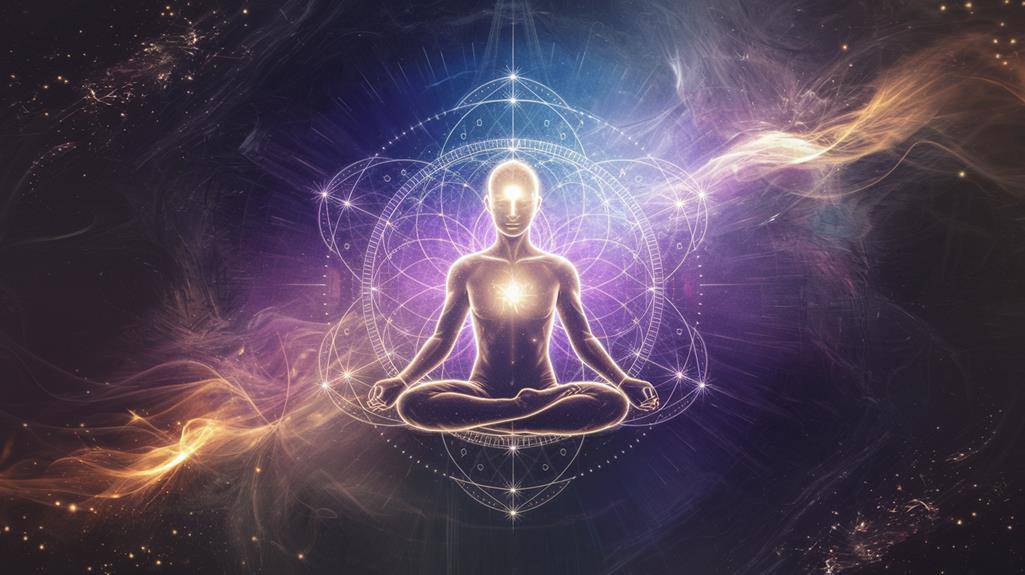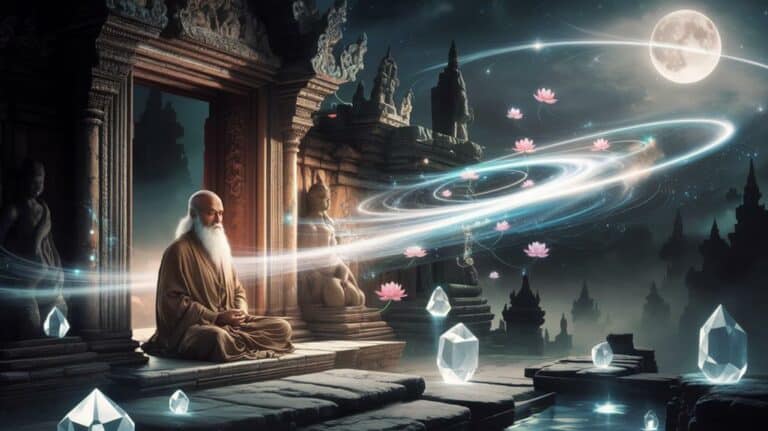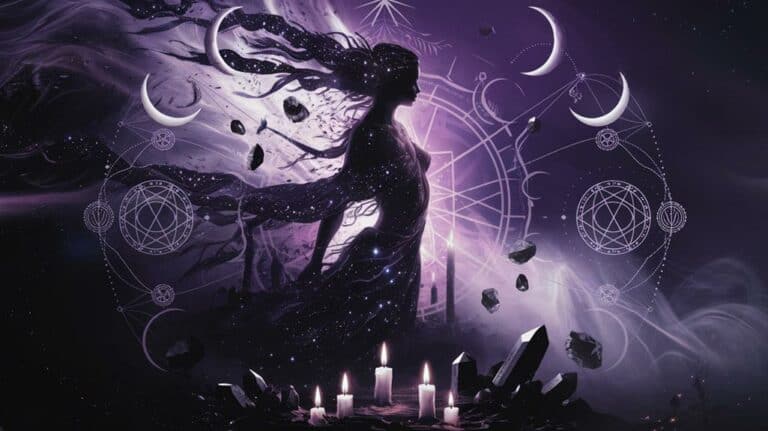What Is Mysticism in Simple Words?
You’ve probably wondered about those moments when you feel strangely connected to something bigger than yourself – that’s where mysticism begins. It’s like having a direct phone line to the divine or ultimate reality, bypassing the need for religious middlemen or complex rituals. You can think of mystics as spiritual explorers who aren’t satisfied with just following rules or accepting what they’re told; they want to experience truth firsthand. Whether through meditation, prayer, or other practices, mystics seek those profound “aha” moments that transform their understanding of life and their place in it. Let’s explore what makes this ancient path so relevant today.
The Core of Mystical Experience
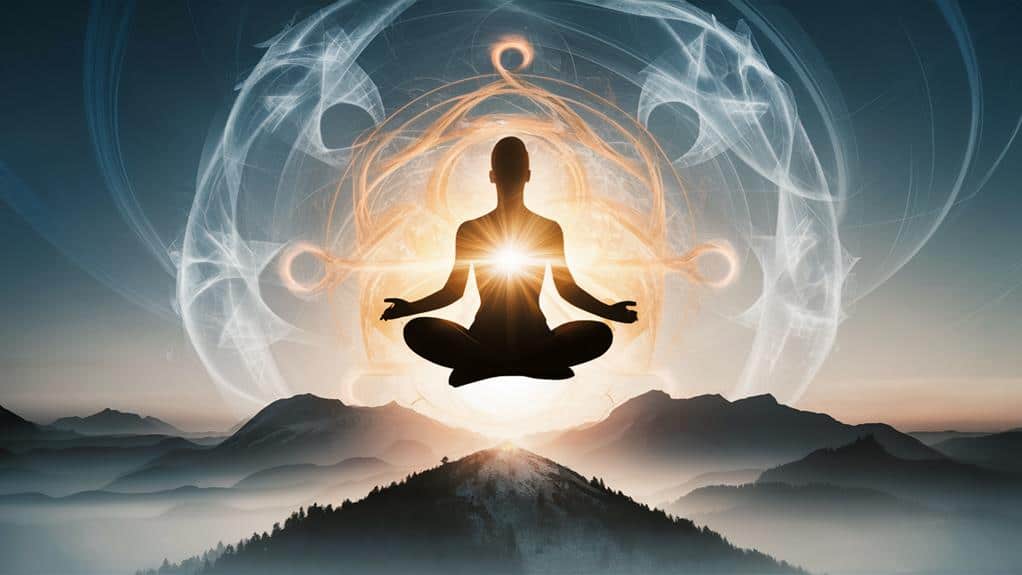
A mystical experience shatters our ordinary perception of reality. In these profound moments, you’ll find yourself stripped of the familiar boundaries that separate you from the world around you. You’re no longer just an observer – you’ve become intimately connected to everything that exists, experiencing a unity that transcends your everyday understanding.
When you enter this state of expanded awareness, you’ll discover that what you’ve always thought of as “you” begins to dissolve. Time doesn’t flow in its usual linear fashion; instead, you’re immersed in an eternal present where past and future lose their meaning.
You’ll feel a deep knowing that can’t be captured in words, yet it reveals truths more real than anything you’ve experienced in ordinary consciousness. Your logical mind will try to make sense of it, but mystical experiences exist beyond the domain of rational thought.
You’re touching something vast and ineffable – a direct encounter with what some call the divine, others name consciousness itself, and still others describe as ultimate reality. This isn’t about believing in something; it’s about knowing through direct experience.
Common Mystical Practices Worldwide
Three core mystical practices appear consistently across cultures and traditions worldwide: meditation, contemplative prayer, and sacred rituals.
You’ll find these ancient methods have endured because they offer direct pathways to transcendent experiences, allowing you to peer beyond the veil of ordinary reality.
When you engage in meditation, you’re following a universal practice that quiets your mind and opens doors to heightened awareness.
You’ll discover that whether you’re sitting in a Zen temple or a mountaintop monastery, the fundamental approach remains unchanged: turning inward to explore consciousness itself.
Through contemplative prayer, you’re participating in a devotional practice that transcends religious boundaries.
You’ll find yourself joining countless others who’ve used sacred words and focused intention to forge deeper connections with the divine.
Sacred rituals, whether they’re performed in indigenous ceremonies or formal religious settings, create structured spaces for mystical encounters.
You’re tapping into timeless wisdom when you participate in these carefully choreographed acts, which often involve specific movements, chants, or offerings that have been refined over generations to facilitate direct spiritual experience.
Historical Roots of Mysticism
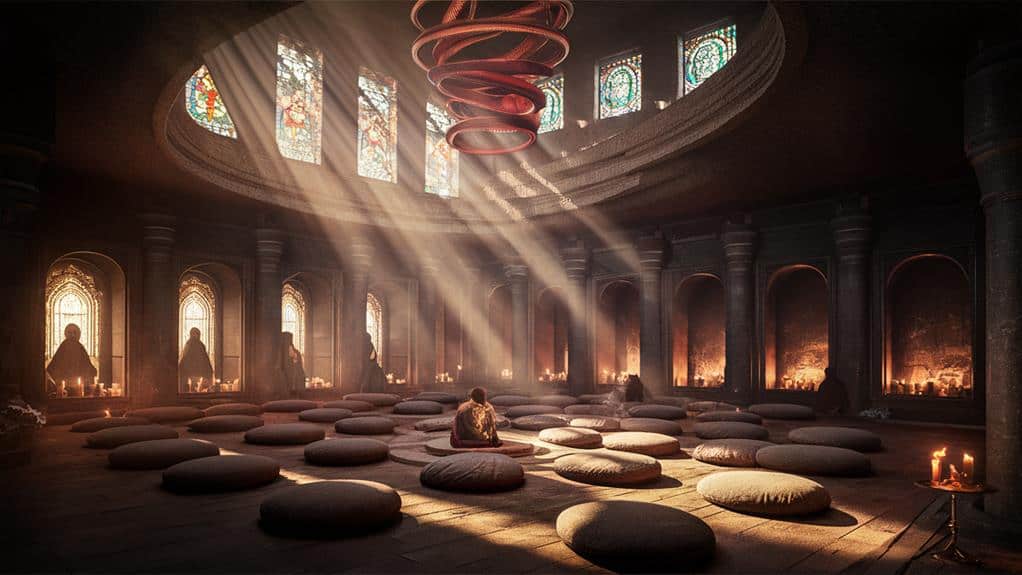
While modern mysticism may seem like a recent phenomenon, its roots stretch back to humanity’s earliest civilizations. You’ll find mystical traditions woven into the fabric of ancient Egyptian temples, where priests sought divine connection through sacred rituals, and in the meditation practices of early Indian sages who explored consciousness in Himalayan caves.
As you trace mysticism’s journey through time, you’ll discover how ancient Greeks like Pythagoras didn’t just teach mathematics – they led mystery schools where initiates explored the soul’s secrets.
In ancient China, Taoist mystics developed practices to align with nature’s rhythms, while indigenous shamans across continents communed with spirit domains through sacred ceremonies.
You’re part of this unbroken lineage that flows through medieval Christian mystics who wrote of divine union, Sufi poets who danced to achieve spiritual ecstasy, and Kabbalistic scholars who mapped the hidden dimensions of reality.
These roots continue to nourish today’s spiritual seekers, showing you that the quest for direct experience of the sacred isn’t new – it’s a fundamental part of human nature that’s as old as consciousness itself.
Mysticism Across Different Religions
Religion’s mystical traditions share striking parallels despite emerging from different cultures and times. You’ll find Sufi mystics whirling in ecstatic dance while Buddhist monks sit in silent meditation, yet both seek the same dissolution of self into divine unity.
Christian contemplatives speak of “divine darkness” while Hindu yogis describe “absorption in Brahman” – different words pointing to the same ineffable experience.
When you explore these traditions deeply, you’ll discover how Jewish Kabbalists’ ascent through spiritual dimensions mirrors the Taoist sage’s journey to primordial emptiness. Each path offers you unique practices: Islamic dhikr (remembrance), Christian centering prayer, Buddhist mindfulness, or Hindu mantra recitation.
Yet they’re all leading you toward that mysterious center where the individual soul meets ultimate reality.
You’ll notice how mystics across faiths describe similar markers along the way: periods of spiritual darkness, moments of extraordinary clarity, and the eventual transcendence of ordinary consciousness.
Whether you’re drawn to the Desert Fathers’ solitude or the communal ecstasy of Hasidic prayer, these traditions offer you pathways to direct spiritual experience beyond religious doctrine.
Signs of Mystical Awakening
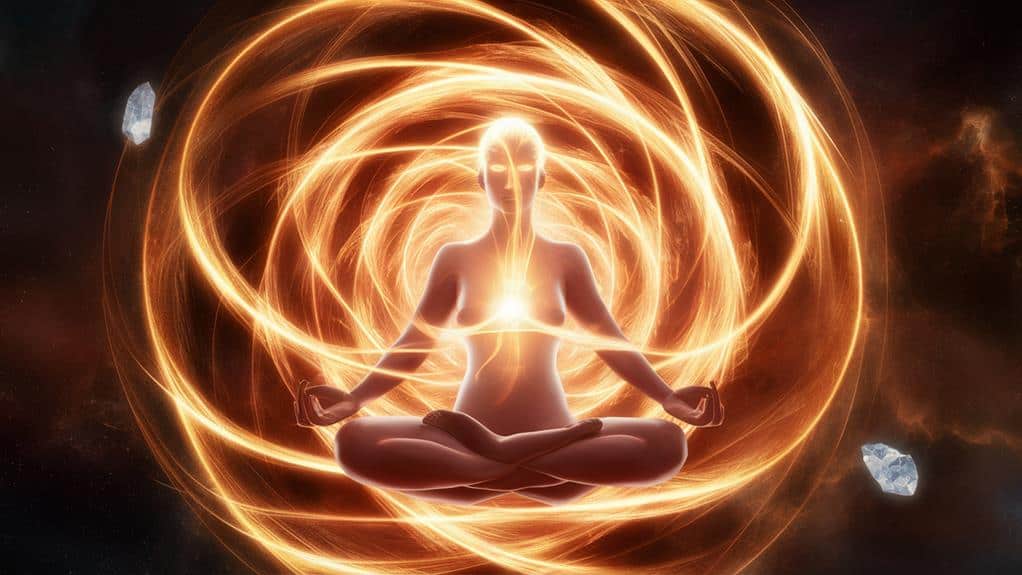
Individuals going through a mystical awakening often report unmistakable signs that mark their spiritual transformation.
You might notice heightened sensitivity to the energies around you, feeling deeply connected to nature and other beings in ways you can’t quite explain. There’s often a profound shift in how you perceive time, with moments stretching into eternity or collapsing into brief flashes of insight.
You’ll likely experience synchronicities – meaningful coincidences that seem to guide your path – and find yourself drawn to solitude and contemplation.
Your dreams may become more vivid and prophetic, while your intuition sharpens to an almost uncanny degree. There’s often a growing sense that you’re part of something far greater than yourself, accompanied by waves of unconditional love and compassion for all beings.
Physical sensations might include tingling in your crown or third-eye area, sudden rushes of energy through your body, or spontaneous tears of joy.
You’re likely to feel less attached to material possessions and social expectations, instead prioritizing authentic self-expression and spiritual growth.
These signs aren’t just random occurrences – they’re illuminating markers on your journey toward expanded consciousness.
The Science Behind Mysticism
Modern research into mystical experiences has uncovered fascinating neurological patterns that bridge the gap between spiritual phenomena and scientific understanding.
When you’re in a deep meditative state or experiencing transcendent moments, your brain exhibits decreased activity in the parietal lobe – the area responsible for processing time, space, and your sense of self. This neural shift helps explain why you might feel a dissolution of boundaries and a connection to something greater during mystical experiences.
Brain imaging studies have revealed that your prefrontal cortex, which handles attention and emotional regulation, becomes highly activated during spiritual practices.
At the same time, you’ll find your default mode network – the brain’s “me center” – showing reduced activity, potentially explaining the ego dissolution many mystics describe.
These findings don’t diminish the profound nature of mystical experiences; rather, they offer a scientific framework for understanding how your consciousness can expand beyond ordinary perception.
You’re witnessing the convergence of ancient wisdom and modern neuroscience, as researchers continue to map the neural correlates of transcendent states that mystics have described for millennia.
Modern Mysticism Today
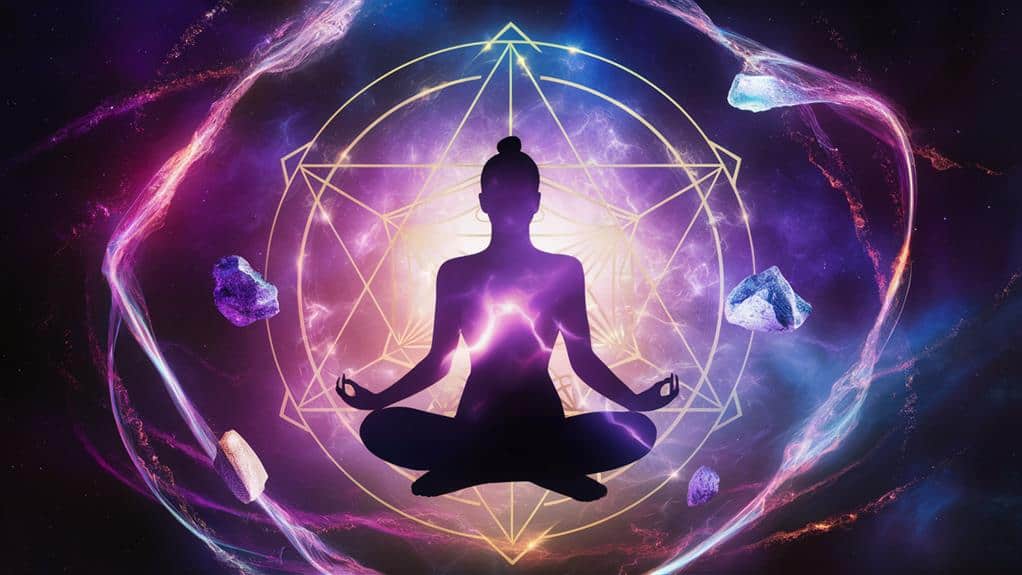
While scientific research illuminates the biological basis of mystical experiences, today’s mystical practices have evolved far beyond traditional religious contexts. You’ll find modern mysticism weaving through diverse paths – from mindfulness apps and guided meditation retreats to breathwork circles and sound healing sessions.
These contemporary expressions embrace both ancient wisdom and new understanding, creating bridges between timeless truths and your daily life. In today’s fast-paced world, you’re not alone if you’re seeking deeper meaning beyond conventional spirituality.
Modern mystics often blend quantum physics with meditation, psychology with energy work, and technology with traditional practices. You’ll discover that mystical experiences aren’t confined to monasteries or sacred sites – they’re accessible in your living room, local community centers, and even through virtual Reality platforms.
What’s particularly striking about modern mysticism is its emphasis on direct, personal experience rather than dogmatic beliefs. You’re encouraged to explore, question, and validate your own mystical journey, while staying grounded in practical reality.
This approach helps you integrate profound spiritual insights into your everyday existence, transforming ordinary moments into opportunities for deeper awareness and connection.
Tools for Mystical Development
Throughout history, mystics have developed specific tools and practices to access heightened states of consciousness. You’ll find these time-tested methods still resonate deeply with modern seekers who yearn to explore the mysteries of existence and consciousness.
Meditation stands as your primary gateway, offering a direct path to transcendent awareness through focused breath work and mindful presence.
You’ll discover that sacred texts and contemplative reading can serve as mirrors, reflecting profound truths while guiding your inner exploration.
Through ritual and ceremony, you’re able to create sacred space and time, marking shifts between ordinary and extraordinary states of consciousness.
Your body itself becomes an instrument of mystical development through movement practices like yoga, tai chi, or sacred dance.
You’ll find that working with symbols, whether through mandala creation or dream interpretation, helps bridge the gap between conscious and unconscious dimensions.
Sound tools – including mantras, singing bowls, and drumming – can shift your brainwave patterns and facilitate altered states.
Nature immersion offers you direct communion with the divine, while journaling captures your insights and tracks your spiritual evolution.
Mysticism Versus Organized Religion
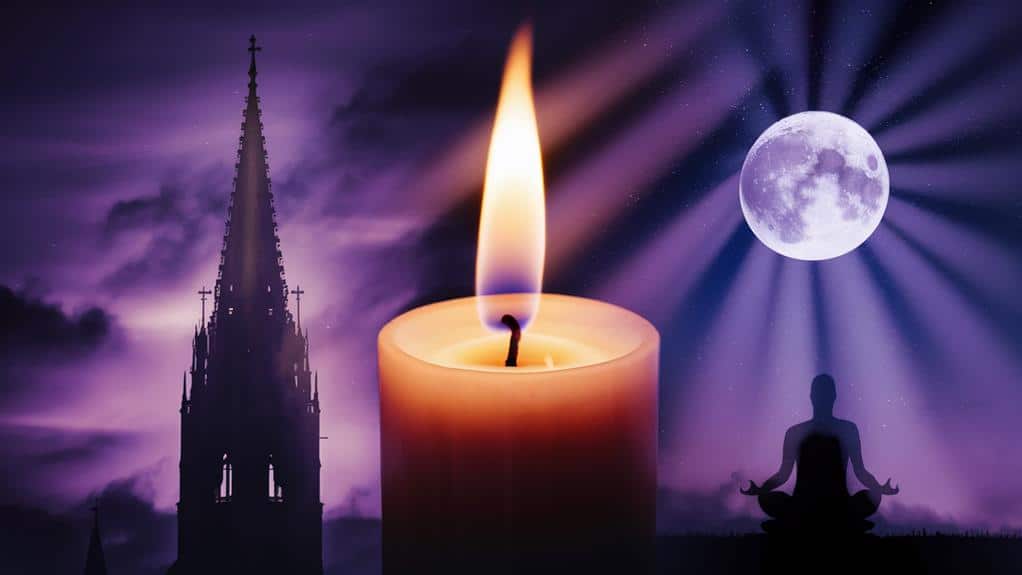
Despite sharing common roots in humanity’s search for meaning, mysticism and organized religion often represent distinctly different approaches to spiritual truth.
While organized religions typically offer structured doctrines, fixed rituals, and hierarchical leadership, mysticism invites you to explore direct, personal experiences of the divine without intermediaries.
You’ll find that mystics across cultures often describe similar experiences of unity and transcendence, even when they come from different religious backgrounds.
Unlike organized religion’s emphasis on collective worship and standardized beliefs, mysticism encourages you to venture beyond established frameworks into the depths of your own consciousness.
You’re not bound by prescribed interpretations but free to discover truth through firsthand experience.
This doesn’t mean you must choose between mysticism and organized religion – many mystics maintain connections to traditional faiths while pursuing their individual paths.
However, you’ll notice that mysticism tends to emphasize personal transformation over institutional conformity, direct revelation over inherited doctrine, and experiential knowing over intellectual belief.
It’s a path that asks you to trust your inner guidance while remaining open to the mystery that lies beyond all human constructs.
Conclusion
You’ll find that mysticism isn’t just an ancient practice but a living, breathing path to deeper understanding of yourself and the universe. Whether you’re drawn to meditation, contemplative prayer, or sacred rituals, your mystical journey offers direct experience of what lies beyond ordinary perception. As you explore this timeless wisdom, you’re joining countless seekers who’ve discovered that the divine isn’t found in dogma, but in direct, transformative experience.



